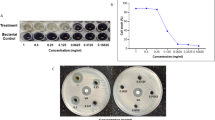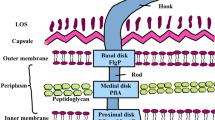Abstract
The appearance of the super bacteria arose from mis- or abuse of antibiotics lead to the increasing interest about strong and safety new antibiotics. Angelica dahurica Bentham et Hooker (ADBH) is a herbal antibiotic drug which has been frequently prescribed in oriental pharmacology and has historically proven to be effective for bacterial infection. However, the molecular mechanism of the herbal antibiotic has not been cleared. Here, we examined the ADBH’s antibiotic mechanism at the molecular level. We have focused on the simultaneous multi-target inhibitory effect of the of the ADBH ethyl acetate (EA) fraction on the enterohemorrhagic Escherichia coli O157:H7. Disk diffusion and DNA microarray was performed to investigate the molecular mechanism of the ADBH’s antibiotic effect, and real-time quantitative PCR was employed to confirm the microarray data. The inhibitory effect of the ADBH EA fraction was on the bacterial cell envelope formation, folate biosynthesis, DNA replication and etiological factors of the E. coli O157:H7. This multi-target efficacy of the herbal antibiotic may be used as more effective and safer drugs that substitute existing antibiotics.
Similar content being viewed by others
References
Holtz, L.R., Neill, M.A. & Tarr, P.I. Acute bloody diarrhea: a medical emergency for patients of all ages. Gastroenterology 136, 1887–1898 (2009).
Tarr, P.I., Gordon, C.A. & Chandler, W.L. Shiga-toxinproducing Escherichia coli and haemolytic uraemic syndrome. Lancet 365, 1073–1086 (2005).
Jenke, C. et al. Phylogenetic analysis of enterohemorrhagic Escherichia coli O157, Germany, 1987–2008. Emerg. Infect. Dis. 16, 610–616 (2010).
U.S. FDA. 12 Dec Immediate Release P06-197 (2006).
Dehority, W. Use of vancomycin in pediatrics. Pediatr. Infect. Dis. J. 29, 462–464 (2010).
May, T., Ito, A. & Okabe, S. Induction of multidrug resistance mechanism in Escherichia coli biofilms by interplay between tetracycline and ampicillin resistance genes. Antimicrob. Agents Chemother. 53, 4628–4639 (2009).
Kim, K.-S. et al. Global transcriptome analysis of the Escherichia coli O157 response to Houttuynia Cordata Thunb. BioChip J. 4, 237–246 (2010).
Yang, h.J. et al. Global transcriptome analysis of the E. coli O157 response to Agrimonia pilosa extract. Mol. Cell. Toxicol. 7, 299–310 (2011).
Choi, E.-K. et al. Genome-wide gene expression analysis of Patrinia scabiosaefolia reveals an antibiotic effect. BioChip J. 5, 246–254 (2011).
Lechner, D., Stavri, M., Oluwatuyi, M., Pereda-Miranda, R. & Gibbons, S. The anti-staphylococcal activity of Angelica dahurica (Bai Zhi). Phytochemistry 65, 331–335 (2004).
Kwon, Y.S. et al. Antimicrobial constituents of Angelica dahurica roots. Phytochemistry 44, 887–889 (1997).
Jang, H.J., Nde, C., Toghrol, F. & Bentley, W.E. Global transcriptome analysis of the Mycobacterium bovis BCG response to sodium hypochlorite. Appl. Microbiol. Biotechnol. 85, 127–140 (2009).
Jang, H.J., Nde, C., Toghrol, F. & Bentley, W.E. Microarray analysis of Mycobacterium bovis BCG revealed induction of iron acquisition related genes in response to hydrogen peroxide. Environ. Sci. Technol. 43, 9465–9472 (2009).
Jang, H.J., Chang, M.W., Toghrol, F. & Bentley, W.E. Microarray analysis of toxicogenomic effects of triclosan on Staphylococcus aureus. Appl. Microbiol. Biotechnol. 78, 695–707 (2008).
Jang, H.J., Nde, C., Toghrol, F. & Bentley, W.E. Microarray analysis of toxicogenomic effects of orthophenylphenol in Staphylococcus aureus. BMC Genomics 9, 411 (2008).
Whitfield, C. Biosynthesis and assembly of capsular polysaccharides in Escherichia coli. Annu. Rev. Biochem. 75, 39–68 (2006).
Reynolds, P.E. Structure, biochemistry and mechanism of action of glycopeptide antibiotics. Eur. J. Clin. Microbiol. Infect. Dis. 8, 943–950 (1989).
Plumbridge, J. An alternative route for recycling of Nacetylglucosamine from peptidoglycan involves the Nacetylglucosamine phosphotransferase system in Escherichia coli. J. Bacteriol. 191, 5641–5647 (2009).
Golub, E.I. & Panzer, H.A. The F factor of Escherichia coli carries a locus of stable plasmid inheritance stm, similar to the parB locus of plasmid RI. Mol. Gen. Genet. 214, 353–357 (1988).
Gerdes, K. et al. Mechanism of postsegregational killing by the hok gene product of the parB system of plasmid R1 and its homology with the relF gene product of the E. coli relB operon. EMBO J. 5, 2023–2029 (1986).
Gerdes, K. & Wagner, E.G. RNA antitoxins. Curr. Opin. Microbiol. 10, 117–124 (2007).
Scholte, A.A., Eubanks, L.M., Poulter, C.D. & Vederas, J.C. Synthesis and biological activity of isopentenyl diphosphate analogues. Bioorg. Med. Chem. 12, 763–770 (2004).
Rida, S., Caillet, J. & Alix, J.H. Amplification of a novel gene, sanA, abolishes a vancomycin-sensitive defect in Escherichia coli. J. Bacteriol. 178, 94–102 (1996).
Lupoli, T.J. et al. Studying a cell division amidase using defined peptidoglycan substrates. J. Am. Chem. Soc. 131, 18230–18231 (2009).
Priyadarshini, R., de Pedro, M.A. & Young, K.D. Role of peptidoglycan amidases in the development and morphology of the division septum in Escherichia coli. J. Bacteriol. 189, 5334–5347 (2007).
Korsak, D., Liebscher, S. & Vollmer, W. Susceptibility to antibiotics and beta-lactamase induction in murein hydrolase mutants of Escherichia coli. Antimicrob. Agents Chemother. 49, 1404–1409 (2005).
Pytel, D., Slupianek, A., Ksiazek, D., Skorski, T. & Blasiak, J. [Uracil-DNA glycosylases]. Postepy Biochem. 54, 362–370 (2008).
Camara, J.E., Skarstad, K. & Crooke, E. Controlled initiation of chromosomal replication in Escherichia coli requires functional Hda protein. J. Bacteriol. 185, 3244–3248 (2003).
Ross, W., Thompson, J.F., Newlands, J.T. & Gourse, R.L. E. coli Fis protein activates ribosomal RNA transcription in vitro and in vivo. EMBO J. 9, 3733–3742 (1990).
Allen, G.C., Jr. & Kornberg, A. The priB gene encoding the primosomal replication n protein of Escherichia coli. J. Biol. Chem. 266, 11610–11613 (1991).
Devroede, N., Thia-Toong, T.L., Gigot, D., Maes, D. & Charlier, D. Purine and pyrimidine-specific repression of the Escherichia coli carAB operon are functionally and structurally coupled. J. Mol. Biol. 336, 25–42 (2004).
Morita, Y., Sobel, M.L. & Poole, K. Antibiotic inducibility of the MexXY multidrug efflux system of Pseudomonas aeruginosa: involvement of the antibiotic-inducible PA5471 gene product. J. Bacteriol. 188, 1847–1855 (2006).
Okusu, H., Ma, D. & Nikaido, H. AcrAB efflux pump plays a major role in the antibiotic resistance phenotype of Escherichia coli multiple-antibiotic-resistance (Mar) mutants. J. Bacteriol. 178, 306–308 (1996).
Cohen, S.P., Hachler, H. & Levy, S.B. Genetic and functional analysis of the multiple antibiotic resistance (mar) locus in Escherichia coli. J. Bacteriol. 175, 1484–1492 (1993).
Cohen, S.P., McMurry, L.M. & Levy, S.B. marA locus causes decreased expression of OmpF porin in multiple-antibiotic-resistant (Mar) mutants of Escherichia coli. J. Bacteriol. 170, 5416–5422 (1988).
Conlan, S. & Bayley, H. Folding of a monomeric porin, OmpG, in detergent solution. Biochemistry (Mosc). 42, 9453–9465 (2003).
Mizuno, T., Kato, M., Jo, Y.L. & Mizushima, S. Interaction of OmpR, a positive regulator, with the osmoregulated ompC and ompF genes of Escherichia coli. Studies with wild-type and mutant OmpR proteins. J. Biol. Chem. 263, 1008–1012 (1988).
Breazeale, S.D., Ribeiro, A.A. & Raetz, C.R. Oxidative decarboxylation of UDP-glucuronic acid in extracts of polymyxin-resistant Escherichia coli. Origin of lipid a species modified with 4-amino-4-deoxy-L-arabinose. J. Biol. Chem. 277, 2886–2896 (2002).
Higashi, K. et al. Identification of a spermidine excretion protein complex (MdtJI) in Escherichia coli. J. Bacteriol. 190, 872–878 (2008).
Fukuchi, J., Kashiwagi, K., Yamagishi, M., Ishihama, A. & Igarashi, K. Decrease in cell viability due to the accumulation of spermidine in spermidine acetyltransferase-deficient mutant of Escherichia coli. J. Biol. Chem. 270, 18831–18835 (1995).
Igarashi, K. & Kashiwagi, K. Characteristics of cellular polyamine transport in prokaryotes and eukaryotes. Plant Physiol. Biochem 48, 506–512 (2010).
Sandvig, K, Bergan, J, Dyve, AB, Skotland, T & Torgersen, M.L. Endocytosis and retrograde transport of Shiga toxin. Toxicon 56, 1181–1185 (2010).
Garcia-Contreras, R., Zhang, X.S., Kim, Y. & Wood, T.K. Protein translation and cell death: the role of rare tRNAs in biofilm formation and in activating dormant phage killer genes. PLoS One 3, e2394 (2008).
Nieto, J.M. et al. The hha gene modulates haemolysin expression in Escherichia coli. Mol. Microbiol. 5, 1285–1293 (1991).
Harrison, J.W. & Svec, T.A. The beginning of the end of the antibiotic era? Part I. The problem: abuse of the “miracle drugs”. Quintessence Int. 29, 151–162 (1998).
Dimitrakov, J., Tchitalov, T., Zlatanov, D. & Dikov, D. A prospective, randomized, double-blind placebocontrolled study of antibiotics for the treatment of category liib Chronic Pelvic Pain syndrome in Men. Third International Chronic Prostatitis Network (2009).
Kelesidis, T. & Canseco, E. Levofloxacin-induced hypoglycemia: a rare but life-threatening side effect of a widely used antibiotic. Am. J. Med. 122, e3–4 (2009).
Shahien, R., Vieksler, V. & Bowirrat, A. Amoxicillininduced aseptic meningoencephalitis. Int. J. Gen. Med. 3, 157–162 (2010).
Rengarajan, J. et al. The folate pathway is a target for resistance to the drug para-aminosalicylic acid (PAS) in mycobacteria. Mol. Microbiol. 53, 275–282 (2004).
Falagas, M.E. & Kasiakou, S.K. Toxicity of polymyxins: a systematic review of the evidence from old and recent studies. Crit. Care. 10, R27 (2006).
Nde, C.W., Jang, H.J., Toghrol, F. & Bentley, W.E. Toxicogenomic response of Pseudomonas aeruginosa to ortho-phenylphenol. BMC Genomics 9, 473 (2008).
Author information
Authors and Affiliations
Corresponding author
Rights and permissions
About this article
Cite this article
Kim, KS., Yang, H.J., Choi, EK. et al. The multi-target antibiotic efficacy of Angelica dahurica Bentham et Hooker extract exposed to the Escherichia coli O157:H7. BioChip J 5, 333–342 (2011). https://doi.org/10.1007/s13206-011-5407-6
Received:
Accepted:
Published:
Issue Date:
DOI: https://doi.org/10.1007/s13206-011-5407-6




